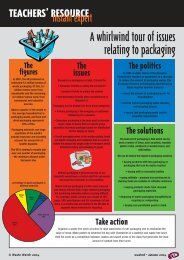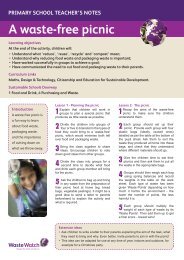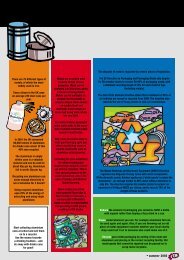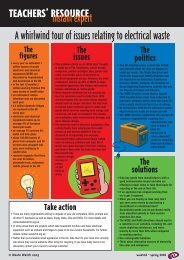organic waste - pdf 1mb - Recyclezone
organic waste - pdf 1mb - Recyclezone
organic waste - pdf 1mb - Recyclezone
You also want an ePaper? Increase the reach of your titles
YUMPU automatically turns print PDFs into web optimized ePapers that Google loves.
TEACHERS’ RESOURCEinstant expertA whirlwind tour of issues relating tohousehold <strong>waste</strong> and compostingThefiguresIn the UK about 29.3 milliontonnes of domestic rubbish isproduced each year.Over 60% of this isbiodegradable, with anaverage of 38% made upof food <strong>waste</strong> (such asvegetable peelings, tea bagsand food scraps) and other<strong>organic</strong> materials (such aspaper and cardboard).TheissuesCompost forms as a result of thenatural breakdown of <strong>organic</strong> materialderived from living animals and plants.Composting is an aerobic process(i.e. it uses oxygen) performed by thebacteria, fungi, insects and animalswhich inhabit soil.Micro-organisms convert the materialinto carbon dioxide, water vapour anda stable residue, compost.Composting is nature's own and oldestmethod of <strong>waste</strong> disposal and soilfertilisation. However, when <strong>organic</strong>materials are buried in landfill sitesthey are deprived of oxygen and theydecompose anaerobically, generatingmethane and a potentially hazardousliquid called leachate. The <strong>organic</strong>materials within a landfill are the mainsource of methane, a greenhouse gaswhich causes 20 times as much globalwarming as CFCs.Compost is valuable asThe politicsAn EC directive, known as the Landfill Directive (1999/31/EC)aims to reduce methane emissions from landfill by phasingout the landfilling of biodegradable <strong>waste</strong>. A draft UK strategyaims to reduce biodegradable <strong>waste</strong> entering landfill to 75% of1995 levels by 2010.Concerns following disease outbreaks such as Foot and Mouthhave led to the introduction of tighter controls on commercialcomposting operations.The solutionsCompost your <strong>organic</strong> <strong>waste</strong>, either at home in yourgarden, or centrally through kerbside collection schemesor a civic amenity site.In 2001-2002, 78% of the UK’sdomestic <strong>waste</strong> ended up inlandfill sites.Between 50kg and 125kg ofbiodegradable garden <strong>waste</strong>is generated per personeach year in the UK.© Waste Watch 2004• soil fertiliser• mulch• soil conditioner, improvingsoil structure in both clayand sandy soils• it reduces soil erosion andstops desertification• It can also be used in‘bioremediation’ to restorecontaminated soilsTake actionSet up your own compost heap and see how quickly yourmicro-army make it their home and get to work turningyour <strong>waste</strong> into compost. You will need to get the rightbalance between the nitrogen-rich food based materials,and the high carbon materials such as straw andleaves. Add all your <strong>organic</strong> <strong>waste</strong> to your compostsystem. Remember, that items such as cardboard andpaper can be added to the composting mix, and they willprovide much needed carbon to nitrogen rich kitchen <strong>waste</strong>For those without the space for a compost heap, a wormcomposting bin is an alternative for recycling your kitchen<strong>waste</strong>. Worm compost is five times richer than most fertilesoil, and a worm bin can even be kept indoors.Use compost in your gardening wherever possible.However, if you do buy soil improver rather than makingyour own, ensure that you avoid peat based composts, asthe peat is often taken from fragile wetland ecosystems.Alternatively, ask your local civic amenity site for a sourceof recycled compost or soil conditioner.For more information on how to make compost visitthe Henry Doubleday Research Associationwww.hdra.org.uk and the Composting Associationwww.compost.org.uk<strong>waste</strong>d • spring 2004 5
TEACHERS’ RESOURCEprimary yearsCompost time lineComposting is an excellent way to recycle your old fruit andvegetable <strong>waste</strong>. Did you know there are all sorts of othermaterials that can be composted too? And, that different materialstake different amounts of time to break down?In teams, have a go at putting the cards printed below into acompost timeline which shows how long it takes for differentmaterials to decay in your compost bin. Use the phrases on thebottom of the cards to help you line them up in the correct order.Put the fastest material to decay at one end and the slowest atthe other! If you like you can make a giant cardboard worm to putthe cards on. Divide the worm into ten segments and at the headwrite "fastest to decay", and at the tail write "slowest to decay".You will need• a set of compost timeline cards for each group• samples of each material to accompany the timeline cards (optional)• giant cardboard worm for each group (optional)ANSWERS(Fastest) grass > young weeds > potato peelings > tea bags >nettles > thistles > autumn leaves > hedge clippings > tree branches> cardboard (slowest).tree branchestree branches are faster thancardboard, but slower thanautumn leavescardboardcardboard is the slowestgrasspotato peelingsthistlesteabagsgrass is faster than potato peelingspotato peelings are slower thanyoung weeds but faster than nettlesthistles are slower than bothnettles and tea bagstea bags are slower than potatopeelings but faster than bothnettles and thistlesnettlesyoung weedsautumn leaveshedge clippingsnettles are faster than both thistlesand autumn leaves, but not asfast as potato peelingsyoung weeds are slower thangrass, but faster than tea bagsautumn leaves are found fourthfrom bottom and are slowerthan thistleshedge clippings are not as fastas autumn leaves but faster thantree branches6 spring 2004 • <strong>waste</strong>d© Waste Watch 2004
TEACHERS’ RESOURCEsecondary yearsKnow your compost• Compost bacteria are thermophilic which means they need warm conditions tolive. As bacteria get busy eating the food and green <strong>waste</strong> they also create lots ofheat of their own. It can reach 75 C inside a compost heap and you may seesteam rising as water evaporates. These high temperatures are also essential tokill harmful bacteria which may be present in the compost, such as Salmonellawhich causes food poisoning.• Bacteria need a healthy balanced diet just like us.They need chemicals from food to use for growth,movement, making energy and reproduction.Bacteria need carbon from woody things liketwigs and paper, and nitrogen from green thingslike sprouts and dead flowers.During the winter, a young fox warms itself on acommercial compost heap in EssexHow nitrifying bacteria, one of the organisms that plays an important role incomposting, looks under the microscopeCompost is <strong>organic</strong> material that has been biologically broken down (orbiodegraded) by micro organisms such as bacteria and fungi. Without bacteria,food and green <strong>waste</strong> would take much longer to breakdown into compost.Eventually, healthy bacteria will change the <strong>organic</strong> material into something thatlooks and smells like soil but is actually called humus. The humus adds vitalnutrients to the soil and helps plants to grow. To keep bacteria growing happilyand staying healthy, they need the right conditions.• Shredding the <strong>organic</strong> material that is being composted increases the surface areathat is exposed to the bacteria. This means the bacteria have more to feed on andwork quicker.• The bacteria in compost require aerobic conditions. In other words, they needoxygen to thrive. That’s why it’s important to keep a compost heap loosely packedso air can circulate. It’s also important to introduce more oxygen into the compostheap by turning all the food and green <strong>waste</strong>. At home, compost heaps should beturned every 6 months, but large industrial compost heaps are turned every 12to 14 weeks.• Carbon dioxide is produced as a by-product of the composting process. Turningthe compost also helps to let carbon dioxide out which otherwise would start topoison the bacteria.• The other essential ingredient for compost bacteria is water. Ideally, the <strong>organic</strong>material will be slightly moist. However, should the compost become waterloggedthe bacteria will not be able to obtain the necessary oxygen.Lifecycle of a worm – nature’s great recyclersCommercial compostingCommercial composting uses specialmachines to turn the compost, allowingoxygen in, and carbon dioxide out.Industrial scale production of compost, often called commercial composting,uses garden and kitchen <strong>waste</strong> from kerbside recycling schemes or civicamenity sites. This <strong>organic</strong> material is often referred to as the feedstock.The most common industrial composting system is a large scale version ofa garden compost heap. The compost is often arranged in long triangularshaped piles called windrows. The compost is turned by specially designedmachines, or has air blown in through pipes laid underneath the compost.Other compost systems used closed vessels to contain the compost whichallow the temperature and moisture levels to be controlled precisely.Industrially produced humus is often bagged and sold in garden centres aspeat replacement. This reduces the environmental impact of removing peatfrom fragile swamp and bog ecosystems.Worms are one of the most important creatures thathelp in the decomposition of <strong>organic</strong> matter in thesoil. An earthworm eats dead leaves and other<strong>organic</strong> matter. The remains of an earthworm’s foodpasses along its body and are pushed out to form aworm cast or worm pooh! Worm casts are full ofnutrients which enrich the soil. Their burrows alsohelp to aerate the soil and let water drain away.The earthworm is one of the most commonworms. It has a moist, brown skin and can be up to30 centimetres long. Its body has many sectionscalled segments. These segments have tiny hairscalled bristles that help the worm to grip the ground.It does not have any legs but moves through the soilby stretching the front half of the body forward andthen pulling the tail end up towards the front.Worms are hermaphrodites. This means that eachworm has both male and female reproductiveorgans. However, two worms are still needed in orderfor them to reproduce as they cannot self-fertilise.Worms mate when the weather is warm anddamp. The two worms lie next to one another andwrap themselves together with slime. They may stayclose like this for several hours.After mating, the saddle in the middle of eachworm makes a sticky belt of mucus. Worms layabout 20 eggs inside this sticky belt. When ready tolet the eggs hatch, the worm wriggles out of thesaddle and leaves it in the soil. The saddle thenseals up and makes a hard cocoon. The worms’eggs take several weeks or even months to hatchfrom the cocoon.The young earthworms are about as long as athumbnail, are whiter than the adults and have nosaddles. It takes about 18 months for a young wormto grow up and lay eggs of its own. Amazingly,earthworms can live for up to 10 years or more.© Waste Watch 2004<strong>waste</strong>d • spring 2004 7
TEACHERS’ RESOURCE world viewFocus on the United KingdomFocus on MalawiNorthAtlanticOceanGulfofBothniaIndian OceanNorthSeaBalticSeaEnglish ChannelLocation Northern EuropePopulation 59 200 000 approx (2002)Capital LondonStaple diet: Britain no longer has a staple diet. The wideavailability of dishes from every corner of the globe hasintroduced such a variety of foods that the average consumerhas considerable choice. According to the British NutritionFoundation, the food available to us provides us with morethan all the necessary nutrients for our needs.Malnutrition: For all the volume of food consumed, statisticsshow malnutrition to be widespread. For example, childreneat less than half of the recommended five portions of fruitand vegetables a day. In an average week, one in five 4-18year olds eat no fruit at all. In contrast, intakes of fatty andsugary foods are significantly above recommendedguidelines.Poverty: According to the National Food Alliance, 13 millionpeople in the UK are living in food poverty i.e. they are unableto afford to eat a balanced dietWhere do the leftovers go? With this abundance of food onthe shelves, what happens to the food we don’t buy? Britainthrows away up to 500,000 tonnes of food each year worthan estimated £400m. It costs a further £50m to dispose ofand this cost will rise because of landfill tax increases. 3000tonnes of food is given to charities or local authorities toredistribute. It is estimated that 20% of food in thecommercial sector (shops, restaurants etc) is thrown away.Of the 20% of fresh fruit andvegetable <strong>waste</strong> Britain’shouses could compost, only2.6% is composted.Source: British NutritionFoundation; National Food Alliance;Sustainweb Food Poverty Project.Location Southeast AfricaPopulation 9 900 000 approx (1998)Capital LilongweStaple diet: Malawi’s staple diet is Nsima – white maizemeal mixed with water and butter or margarine. This isusually served with vegetables or occasionally, fish or meat.Other foods include Mbatata biscuits made from sweetpotato, banana bread, banana fritters and peanut cookies.Malnutrition: According to studies malnutrition rates arenot high in those areas where there is enough food. However,a recent survey showed that 27% of children under 5 areunderweight.Poverty: Malawi was hit by a devastating drought in 2002.The famine affected 3 million people. The situation wasworsened by the loss of national grain reserves and otherpolitical factors. Many families have lost their keybreadwinner and skilled farm labourers due to illness anddeaths from the AIDS epidemic. More than one in seven ofthe population of Malawi have HIV.Where do the leftovers go? Malawi does not have asignificant amount of commercial food <strong>waste</strong>. In rural areas,the only <strong>organic</strong> <strong>waste</strong> is vegetable peelings. This is buriedand left to decompose, then dug up and used as compost.A recent delegation of Malawian visitors to a compostingfacility in Norfolk commented that the masses of wood beingchipped for composting would have been very efficientlyreused for furniture in Malawi, with smaller pieces beingused for firewood for cooking.Source: The National StatisticalOffice of Malawi; The Lonely PlanetGuide to Malawi; The Africa Guide;Malawi Here (www.malawihere.com); Nutrition of Young Childrenand Mothers in Malawi (www.nso.malawi. net/data_on_line/demography/dhs/nutrition_chartbook.<strong>pdf</strong>)8 spring 2004 • <strong>waste</strong>d © Waste Watch 2004
TEACHERS’ useful RESOURCE resourcesAll the information you need is out there on theinternet – somewhere! We tell you where to look.Waste OnlineThis informative website providesinformation on all <strong>waste</strong> issues,including composting. The WasteOnline information sheets provides acomprehensive view of compostingin the UK, from where to buy aworm bin, to EU legislation affectingcomposting targets. The onlinedatabase also includes many otherdocuments on <strong>organic</strong> <strong>waste</strong>.www.<strong>waste</strong>online.org.ukThe Wildlife TrustsThe UK's leading conservationcharity exclusively dedicated towildlife, including the conservationof peat bogs. Just enter ‘peat’ intothe site search engine to find outabout some of the stunning wildlifeunder threat by those lazygardeners who insist on buyingpeat based soil improvers ratherthan good old compost.www.wildlifetrusts.orgGet CompostingFor everything you needed to knowabout home composting.www.getcomposting.comWORMERY SPECIFIC WEB SITESWiggly WigglersWiggly Wigglers are suppliers ofcompost bins, wormeries, wormsand books. They offer friendlyhelp and advice on all aspects ofnatural gardening, conservationand recycling.www.wigglywigglers.co.ukRaring to GrowGardening projects for schoolsincluding worms, wormeriesand composting. This jolly andclearly laid out website will pushyour compost enthusiasm levelssky high!www.raringtogrow.com/worms.htmCOMPOSTING SPECIFIC WEB SITESThe Composting AssociationThe Composting Association is oneof the leading organisationspromoting good practice in compostingand the use of compostedmaterials. Their website hasinformation on all aspects ofcomposting and about itsenvironmental and economicbenefits. There is also informationon commercial compostingschemes.www.compost.org.ukHenry Doubleday ResearchAssociation (HDRA)This website is guaranteed to getyou gardening! HDRA is anenvironmental organisation whichfocuses on <strong>organic</strong> horticultureand related topics such ascomposting and <strong>organic</strong> <strong>waste</strong>recycling. The Schools OrganicNetwork is an excellent part of thewebsite with resources forteachers and children, includingadvice, facts and figures, activities,National Curriculum links andteaching advice. There are evenlovely pictures of the HDRAgardens to keep you happy on arainy day.www.hdra.org.ukWildlife WatchCompost heaps should be teemingwith life - especially minibeastsand fungi that are so importantin the composting process. Thiswebsite looks at composting indetail and celebrates thebiodiversity of the compost heap.www.wildlifewatch.org.uk/helpingwildlife/composting.phpWild KidsThis website includes teachers’notes on composting and otherinspiring ideas for turning yourgarden into a sanctuary for wildlife.www.wildkids.org.uk/teachers/notes1.htmCornell CompostingA very detailed Amercan websiteto help schools with composting.There are sections includingideas for projects, a compost quiz,and weird and unusualcomposting stories.www.compost.css.cornell.edu/Composting_homepage.htmlOllie RecyclesA pupil friendly web site withinformation on wormeries,compost and the 3Rs.www.ollierecycles.com/uk/html/reuse.htmlIts out there on the internet - composting birds!The amazing Brush Turkey that lives in Australia makes acompost heap to keep its eggs in. The heaps are made fromvegetable matter that the male turkey scrapes into a pileusing its powerful feet. The heat generated by decompositionwithin the compost heap keeps the Brush Turkey’s eggs niceand warm while they are incubating.Amazingly, the Brush Turkey tests the temperature of thenest using its tongue and will add or remove materialdepending on whether the nest is too hot or too cold. The nestalso provides ammunition for the turkey against predators.Rangers have spotted the Brush Turkey kicking twigs fromthe nest into the faces of predatory monitor lizards looking tosteal eggs.For more details visit www.scz.org/animals/t/bturkey.html© Waste Watch 2004<strong>waste</strong>d • spring 2004 9








